The Ultimate Smoked Pork Tenderloin Recipe: Achieve Perfectly Juicy, Flavorful Results Every Time
Smoked pork tenderloin is a true culinary delight, living up to its reputation for being incredibly tender, lean, and surprisingly easy to prepare. This versatile cut of meat has become a personal favorite for countless reasons, making it an ideal choice for everything from casual weeknight dinners to elegant special occasion gatherings. My approach involves a two-step process that guarantees maximum flavor and a beautifully caramelized crust: a quick sear to lock in juices, followed by a slow, gentle smoke on a pellet grill. This method requires no complicated binders or excessive rubs; just simple, high-quality seasoning, the subtle kiss of wood smoke, and a luxurious homemade BBQ glaze to finish. The outcome is consistently juicy, deeply flavorful pork, imbued with a delicate smoky depth that makes it an absolute showstopper for any summer barbecue or year-round feast.
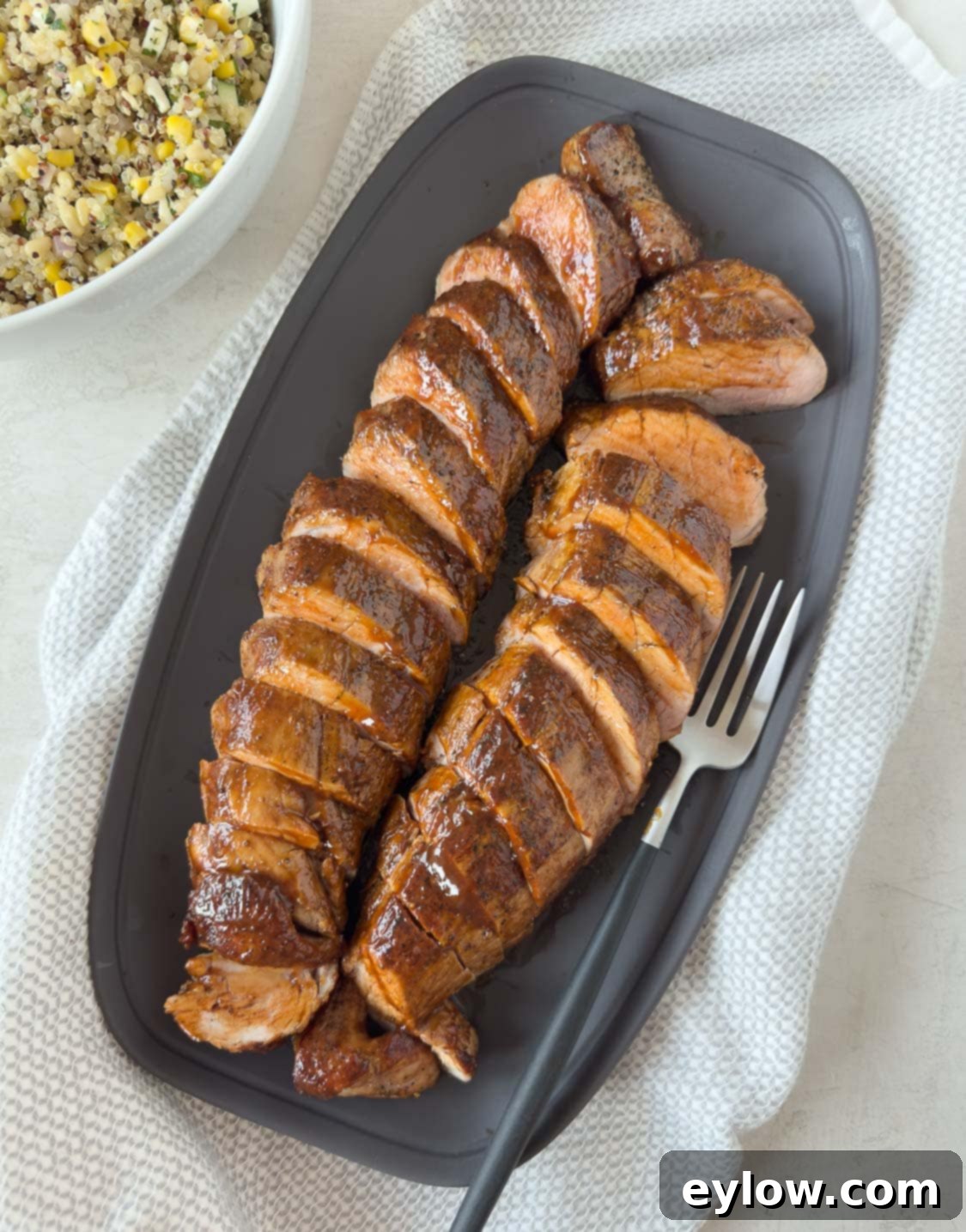
I’ve had the pleasure of preparing this incredible smoked pork tenderloin for friends on many memorable Saturday evenings, often serving it alongside my beloved corn souffle. The initial quick sear at a high temperature is crucial; it instantly creates a rich, mahogany-colored crust that is packed with savory flavor. Following this, the low-and-slow smoking process ensures the interior remains exquisitely tender and a perfect blush pink. A light, glossy homemade barbecue glaze is then brushed on, adding just the right amount of sweetness and a beautiful sheen. For those who love an extra kick, I always recommend serving additional BBQ sauce on the side, allowing everyone to customize their plate to perfection.
[feast_advanced_jump_to]Why You’ll Fall in Love with Smoked Pork Tenderloin
- Unbelievably Tender, Juicy & Flavorful: The magic of low-and-slow smoking is how it gently coaxes flavor into the meat while preventing it from drying out, resulting in a supremely moist interior. The initial sear adds a critical layer of rich color, develops a mouthwatering savory crust, and amplifies the overall taste, creating a symphony of textures and flavors in every bite.
- Remarkably Easy to Cook: Don’t let the “smoked” part intimidate you. This recipe is surprisingly straightforward, requiring minimal hands-on prep. The steps are simple: season the meat, give it a quick sear, then let your smoker do the heavy lifting. A final glaze and slice, and you’re ready to impress.
- Pellet Grill-Friendly & Adaptable: While this recipe shines on a pellet grill, making temperature control and smoke infusion a breeze, it’s incredibly versatile. It can be easily adapted for any traditional smoker, a charcoal grill (using indirect heat and a smoke tube for wood chips), or even a gas grill with a dedicated smoke box or tube, ensuring anyone can achieve fantastic results.
- Simple Seasoning, Spectacular Results: You might be surprised at how much flavor can be achieved with just a few basic ingredients. A generous application of salt and freshly ground black pepper is all it takes to highlight the natural deliciousness of the pork. The optional, but highly recommended, homemade BBQ glaze then elevates it to extraordinary, adding a sweet, tangy, and smoky layer that truly seals the deal.
Throughout the summer months, I frequently pair my smoked pork tenderloin with this vibrant and refreshing quinoa corn salad. It’s a fantastic make-ahead option that tastes even better chilled, offering a perfect counterpoint to the rich, smoky pork.
Essential Ingredients for Smoked Pork Tenderloin

Crafting perfect smoked pork tenderloin starts with a few key, high-quality ingredients. Here’s what you’ll need to gather:
- Pork Tenderloin: The star of our show! I typically look for tenderloins that weigh between 1 to 1¼ pounds each. You might find slightly larger ones depending on your butcher or grocery store. Aim for lean, uniformly shaped cuts for even cooking. Often, tenderloins are sold in packs of two, which is perfect for this recipe.
- BBQ Glaze: While technically optional, a good glaze is highly recommended to add a touch of sweetness, tang, and a beautiful shine. I prefer to use my homemade BBQ sauce, as its fresh flavors truly elevate the dish, but feel free to use your favorite high-quality store-bought brand or another homemade version you love.
- High-Heat Oil: Essential for achieving that perfect initial sear. Choose a clean, neutral-flavored oil that has a high smoke point to prevent burning. I personally use this specific oil (no affiliate link) for its excellent performance and neutral profile, but options like avocado oil or grapeseed oil also work wonderfully.
Additionally, you’ll need sea salt and freshly ground black pepper for seasoning. The precise measurements for these are detailed in the recipe card below. For this particular recipe, you’ll notice there’s no need for a complex dry rub; the simple seasoning allows the natural flavors of the pork and smoke to shine through beautifully.
Creative Substitutions and Flavor Variations
One of the joys of cooking is the ability to adapt recipes to your taste or what you have on hand. Here are some fantastic ways to customize your smoked pork tenderloin:
- Glaze Options Beyond BBQ: While my homemade BBQ sauce is a classic choice for the finish, don’t hesitate to experiment! For a delightful sweet-savory, Asian-inspired twist, consider my homemade hoisin sauce. Alternatively, a maple-mustard glaze (a simple blend of maple syrup, Dijon mustard, and a touch of apple cider vinegar) can introduce a lovely touch of fall flavor, even in the height of summer. You could also opt for a dry rub if you prefer to skip the glaze entirely, perhaps a smoky paprika and garlic blend.
- Pellet Grill Alternatives for Every Setup: No pellet grill? No problem! This versatile recipe can be successfully executed on various cooking apparatuses. You can use any traditional smoker (offset, vertical, or electric), a charcoal grill (set up for indirect heat with wood chunks or chips in a smoker box for that essential smoky flavor), or even a gas grill equipped with a smoker box or smoke tube accessory. For those without an outdoor setup, you can achieve a similar tender result by cooking in the oven at a low temperature, though you’ll miss out on the distinctive smoke flavor unless you use a liquid smoke very sparingly in the glaze or brine.
- The Brining Advantage (Optional): While my recipe yields incredibly juicy results without brining, it’s an excellent optional step if you desire extra moisture and a deeper flavor profile, particularly if you plan to reheat leftovers. Brining can act as an insurance policy against dry meat, enhancing both juiciness and seasoning throughout the tenderloin. You can find a detailed, simple pork brine recipe and instructions conveniently located in the recipe card notes section.
Chef’s Tip – Why I Sear First: A Game-Changer for Flavor and Texture
You might be used to the “reverse sear” method for some cuts of meat, where searing happens at the end. However, for pork tenderloin, I firmly believe in searing first. Here’s why: searing at the beginning instantly creates a magnificent, deeply colored crust that locks in juices and builds incredible flavor right from the start. It also significantly simplifies the cooking process by taking the guesswork out of temperature management. With a reverse sear, it can be tricky to gauge exactly when to pull the tenderloin for its final searing, and the internal temperature can unexpectedly climb higher than desired during that high-heat phase, potentially overcooking your delicate tenderloin. Furthermore, if you’re using a dry rub, applying high heat at the very end can sometimes cause spices to burn, leading to bitter flavors. Searing first avoids these pitfalls, ensuring a perfect crust and precise doneness every time.
Step-by-Step: How to Craft Perfect Smoked Pork Tenderloin
Preparing this smoked pork tenderloin is a rewarding process that delivers incredible flavor with surprisingly little effort. Follow these steps for success:
First, get your pellet grill or smoker ready. If you’re using a gas grill, ensure you have a smoke tube or box filled with wood chips and that you can maintain a consistent low temperature. Always begin with impeccably clean grill grates to prevent sticking and ensure even cooking.
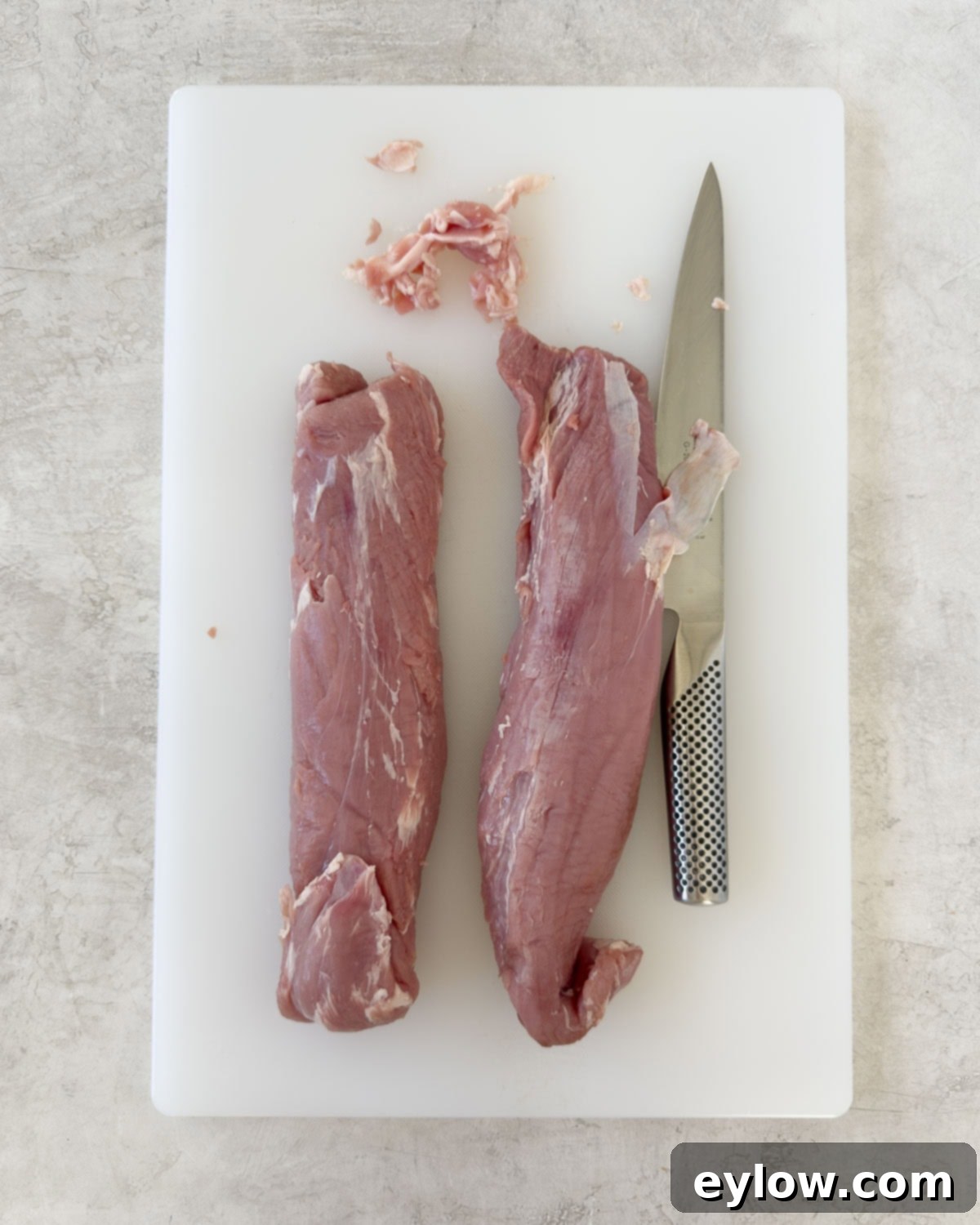
- **Prepare the Pork:** Carefully trim any excess fat and, most importantly, the tough silver skin from the pork tenderloins. Silver skin is a thin, silvery membrane that won’t render or soften during cooking, so removing it ensures a more tender bite.
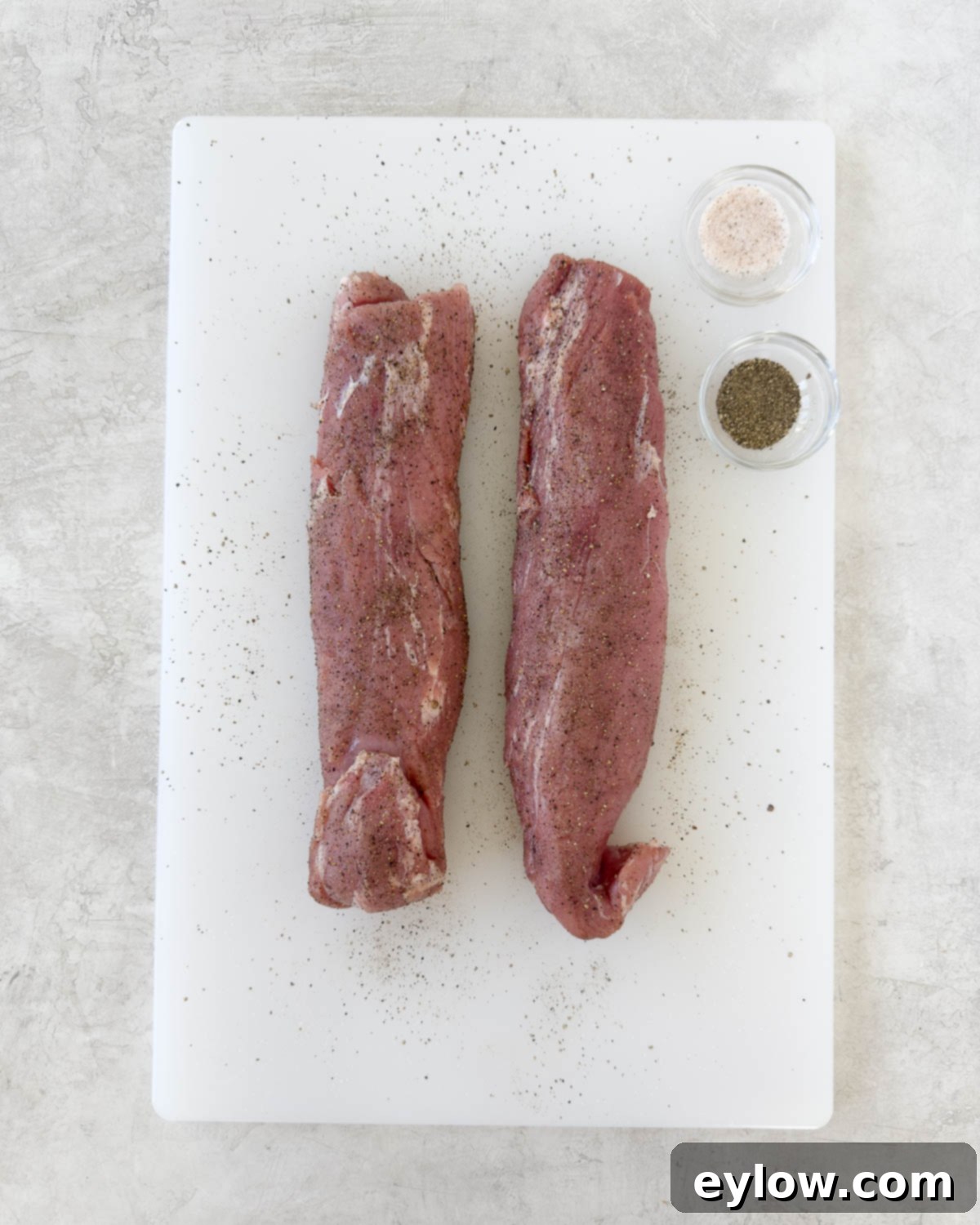
- **Season Generously:** Lightly coat the trimmed pork tenderloins with a neutral high-heat oil. This helps the seasoning adhere and promotes a beautiful crust. Then, season all sides generously and evenly with sea salt and freshly ground black pepper. There’s no need for a complicated rub here; the simple seasoning allows the natural pork flavor to shine.
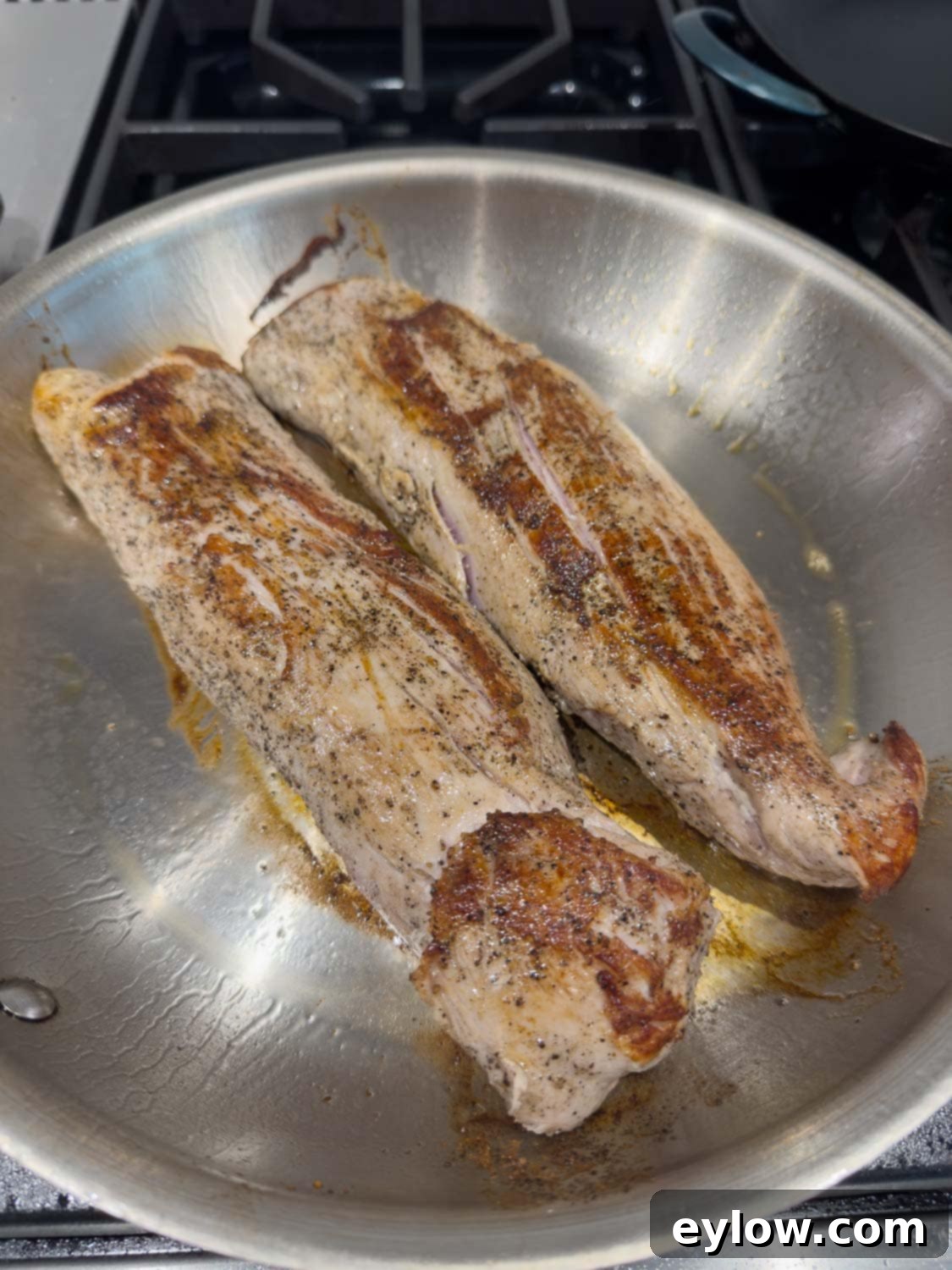
3. **Sear for Flavor and Crust:** Heat a large, heavy-bottomed skillet (preferably cast iron, large enough to comfortably hold both tenderloins) over medium to medium-high heat. Add 2 tablespoons of high-heat oil. Once shimmering, carefully place the tenderloins in the pan. Sear each “flat” side until a beautiful golden-brown crust forms, typically 60-90 seconds per side. Adjust heat as necessary to prevent burning while still achieving good color.

- **Sear the Sides Too:** Don’t forget the rounded sides! Carefully roll the tenderloins to sear all remaining surfaces until they are evenly browned. If the pan appears dry during this process, add just a small amount more oil. Once all sides have achieved that desirable golden-brown color, immediately transfer the seared tenderloins to your pre-heated pellet grill or smoker.

7. **Smoke and Glaze to Perfection:** Place the seared pork tenderloins directly on the grill grates. Insert an internal meat thermometer or probe into the thickest part of one of the tenderloins, ensuring it doesn’t touch bone or fat, to monitor its temperature accurately. Smoke the pork tenderloin at your chosen temperature (refer to the detailed Time & Temperature Guide below for options) until the internal temperature reaches 140-142°F. At this point, remove the tenderloins from the grill and immediately brush them generously with your BBQ glaze. Alternatively, you can apply an initial layer of BBQ sauce 10-15 minutes before the pork is expected to be done, allowing it to caramelize slightly, and then add a final glaze after pulling it from the grill. Let the glazed pork rest for 5-10 minutes (carryover cooking will bring it to the perfect 145°F). Finally, slice the tenderloin cross-grain into medallions and serve immediately with extra BBQ sauce on the side if desired.
Chef’s Tip – Selecting the Best Woods for Smoked Pork Tenderloin
The type of wood you choose for smoking plays a significant role in the final flavor profile of your pork tenderloin. For pork, fruit woods are generally the top recommendation because they impart a mild, subtly sweet flavor that beautifully complements the meat without overwhelming its delicate taste. My personal preference is a well-balanced blend of hardwood hickory, sweet cherry, robust hard maple, and aromatic apple. This combination offers a fantastic depth from the hickory, a delightful sweetness from the fruit woods (cherry and apple), and a well-rounded balance from the maple. This mix ensures a complex, yet harmonious smoky note. Always prioritize high-quality pellets or wood chunks that contain no fillers or artificial binders. This guarantees the cleanest, purest smoke flavor, free from any unwanted chemical aftertastes.
Smoked Pork Tenderloin Time & Temperature Guide
Pork tenderloin is a lean cut of meat, meaning it cooks relatively quickly compared to larger, fattier cuts. For the absolute juiciest and most tender results, it is critical to cook by internal temperature, not just by time. After searing, smoke the tenderloin until a reliable digital meat thermometer inserted into the thickest part reads 140-145°F. Remember that the meat will continue to cook a few degrees after removal (this is called carryover cooking), so pulling it at the lower end of that range (140-142°F) is often ideal for a perfect medium-rare to medium finish. Always allow the pork to rest for 5-10 minutes before slicing to redistribute juices. The times provided below are guidelines only—factors like the tenderloin’s thickness, its starting temperature, ambient conditions (wind, outdoor temperature), and your specific grill’s performance will all play a role. These times are tailored for small 1.0-1.25 lb tenderloins, a common size.
| Smoker Temp | Approx. Time* | Notes |
|---|---|---|
| 225°F | 50–70 minutes | Offers the best balance of robust smoke flavor absorption and moisture retention for a truly tender result. |
| 235°F | 45–65 minutes | A slightly faster option that still allows for good smoke absorption and maintains excellent moisture. |
| 250°F | 28–35 minutes | The fastest cooking option, ideal when you’re short on time, but will result in a milder smoke flavor compared to lower temperatures. |
*Remember, always cook to the internal temperature of the meat, not solely by time, for safe and delicious results.
Chef’s tip: For the juiciest slices, precise temperature management is key. Aim to pull your smoked pork tenderloin from the grill when its internal temperature reaches 140-142°F. The residual heat from the cooking process, known as carryover cooking, will gently bring the temperature up to a perfect 145°F during the essential resting period, ensuring maximum juiciness. If you find yourself needing to speed up the cooking process slightly, you can bump your smoker’s temperature by 10-15°F. However, always prioritize your meat thermometer over the clock; the thermometer is your most reliable guide to perfectly cooked pork.
Versatile Ways to Enjoy Smoked Pork Tenderloin
Once you’ve mastered this smoked pork tenderloin, you’ll find its rich, smoky flavor and tender texture make it incredibly versatile. Here are some of my favorite ways to enjoy it, from a classic dinner to creative leftovers:
- Classic Dinner Experience: Serve the sliced pork tenderloin straight from the smoker for an unforgettable meal. It pairs beautifully with traditional BBQ side dishes. Consider vibrant options like my refreshing quinoa corn salad, a crisp and savory broccoli bacon salad, or comforting whipped sweet potatoes with rosemary. Green beans, coleslaw, or mac and cheese are also excellent companions.
- Dynamic Tacos or Burrito Bowls: Transform leftovers or fresh slices into delicious tacos. Thinly slice the smoked pork, warm it slightly, and tuck it into soft tortillas. Garnish with thinly sliced cabbage for crunch, your favorite grated cheese (like cheddar or Monterey Jack), and a generous drizzle of that amazing homemade BBQ glaze or a zesty buffalo ranch sauce. For a lighter meal, create a vibrant burrito bowl over rice or quinoa with your favorite toppings.
- Gourmet Sandwiches: Elevate your sandwich game with tender smoked pork. Layer thick slices on crusty artisan bread, add a slice of sharp provolone or smoked gouda cheese, some tangy pickled onions, and a creamy smear of Buffalo Ranch sauce or a spicy aioli. Toast the sandwich for an extra layer of deliciousness.
- Efficient Meal Prep: Smoked pork tenderloin is fantastic for meal prepping. Store any leftover slices in airtight containers in the refrigerator for quick and easy lunches throughout the week. It reheats well and is perfect paired with roasted vegetables, a simple green salad, or even a side of sweet potato hash for a wholesome, satisfying meal.
Common Questions About Smoked Pork Tenderloin
For smoked pork tenderloin, fruit woods are generally considered ideal. Woods like apple, cherry, or peach infuse the meat with a mild, slightly sweet smoke flavor that beautifully complements pork without being overpowering. For those who prefer a more complex or bolder profile, a blend of fruit wood with a touch of hickory can be excellent. My personal go-to is a versatile blend of apple, cherry, maple, and hickory pellets, which provides a well-rounded smoky essence.
Brining pork tenderloin before smoking is an optional step. While this specific smoker recipe is designed to yield beautifully juicy results without brining, it can be a beneficial addition. Brining helps to lock in extra moisture, making the meat even more succulent and forgiving, especially if there’s a slight risk of overcooking or if you plan to enjoy leftovers that might be reheated. It also adds an extra layer of flavor throughout the meat. If you’re interested in trying it, you’ll find my simple brine recipe conveniently included in the recipe card notes section.
The smoking time for pork tenderloin can vary depending on its size and the temperature of your smoker. For a typical 1-1.25 lb pork tenderloin smoked at 225°F, you can expect it to take approximately 50-70 minutes. If you increase the temperature to 250°F, the cooking time will be shorter, closer to 28-35 minutes. The most crucial factor is always the internal temperature, not the clock. You should always cook until the thickest part of the tenderloin reaches an internal temperature of 140-145°F. Please refer to my detailed Time & Temperature Guide above for comprehensive information and specific temperature ranges.
Absolutely, you can still achieve fantastic smoked pork tenderloin even without a pellet grill! This smoking method is highly adaptable. You can use a charcoal grill by setting it up for indirect heat and adding wood chunks or chips in a smoker box for the desired smoke flavor. A gas grill can also be used effectively with a smoker box or smoke tube accessory. The key to success, regardless of your equipment, is to maintain a steady low temperature and ensure a consistent source of wood smoke to infuse that signature flavor. Whether you’re using a pellet grill, a stick-burner, or a kamado-style cooker, the principles remain the same for tender, smoky results.
More Terrific Pork Recipes You’ll Love
If you’re a fan of delicious pork, then these other recipes are sure to become new favorites. From quick weeknight meals to impressive cookout centerpieces and special occasion roasts, these pork recipes consistently deliver big, satisfying flavors.
- Pistachio Crusted Pork Rib Roast
- Roast Pork Tenderloin with Dijon Mustard Sauce
- Sour Cream Pork Chops Recipe
- 3-2-1 Ribs (Smoked Baby Back Ribs Recipe)
Did You Make This Recipe?
If you’ve tried your hand at this mouthwatering smoked pork tenderloin recipe, I would absolutely love to hear about your experience! Please take a moment to add your comment below and let me know what version you made and how it turned out. Your feedback is incredibly valuable, not only to me but also to other readers who are looking to try the recipe. If you loved it, a 5-star rating would be truly appreciated and helps more food enthusiasts discover this fantastic dish!
📖 Recipe
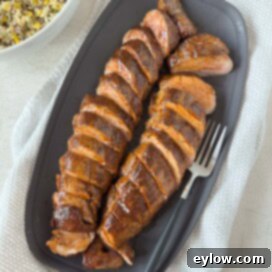
Smoked Pork Tenderloin
Sally CameronEquipment
- 12″ fry pan or larger skillet to handle the length of the pork tenderloins
Ingredients
- 2 pounds pork tenderloins buy 2 1-pound pieces
- ½ teaspoon sea salt or as needed
- ½ teaspoon ground black pepper or as needed
- ¼ cup BBQ sauce to glaze plus extra for serving if desired
- 2-3 tablespoons oil for searing see note below
Instructions
Prep the pork and grill
- Pre-heat your pellet grill or smoker to your desired temperature, typically between 225°F and 250°F (refer to the guide below for specific recommendations). Ensure the grill grates are thoroughly cleaned and lightly oiled to prevent sticking.
- Carefully trim any excess fat and the tough silver skin from the pork tenderloins. Once trimmed, lightly coat the tenderloins with a neutral high-heat oil. Season all sides generously with sea salt and freshly ground black pepper. Heat a large, heavy-bottomed frying pan or skillet over medium to medium-high heat, add 2 tablespoons of oil, and sear the pork tenderloins on all sides until they develop a beautiful golden-brown crust. Watch the heat closely and adjust as needed to prevent burning.
Grill the pork
- Transfer the seared pork tenderloins to the pre-heated grill grates. Insert a wireless meat thermometer or probe into the thickest part of one tenderloin to monitor its internal temperature accurately. Smoke the pork until it reaches an internal temperature of 140°F- 142°F. Remove the tenderloins from the grill and immediately glaze them generously with your favorite BBQ sauce. Allow the pork to rest for 5-10 minutes (the internal temperature will rise a few degrees to 145°F during this time), then slice crosswise into medallions and serve. Offer extra BBQ sauce on the side for those who desire more.
Notes
Oil note: For high heat searing and other cooking needs, I use a clean, neutral, healthy oil called Zero Acre Farm. Order it online, it’s terrific.
Basic Small-Batch Pork Tenderloin Brine (Optional)
To prepare a simple brine, combine 2 quarts of cold water, ½ cup of kosher salt, and ¼ cup of brown sugar (or golden monk fruit sweetener for a lower-sugar option). For added aromatics and flavor, you can also include 2 smashed garlic cloves, 1 teaspoon of whole peppercorns, 2 sprigs of fresh herbs like thyme or rosemary, and a bay leaf. Stir the mixture thoroughly until the salt and sugar are completely dissolved. Place your pork tenderloins into a large zip-top bag or a shallow casserole dish. Pour the prepared brine over the tenderloins, ensuring they are completely submerged. Refrigerate for 1–2 hours. After brining, remove the pork, pat it thoroughly dry with paper towels, and then proceed with the recipe as directed.Cooking temps and times
Pork tenderloin is a lean cut and cooks relatively quickly. Always use a reliable digital meat thermometer and aim for an internal temperature of 140–145°F in the thickest part. After reaching this temperature, remove the pork from the heat and allow it to rest for 5–10 minutes; this crucial step allows the juices to redistribute and the temperature to rise slightly due to carryover cooking. Remember that cooking time is only a guideline—the actual time will vary based on factors such as the tenderloin’s initial thickness, its starting internal temperature, external conditions like wind, and the specific performance of your grill. These ranges reflect a typical size of 1.0–1.25 lb tenderloins.- 225°F: Approximately 50-70 minutes for a perfectly smoky and juicy result.
- 235°F: Roughly 45-65 minutes for a slightly faster cook while still maintaining excellent flavor and moisture.
- 250°F: Expect about 28-40 minutes for the quickest smoking option, though with a slightly milder smoke penetration.
